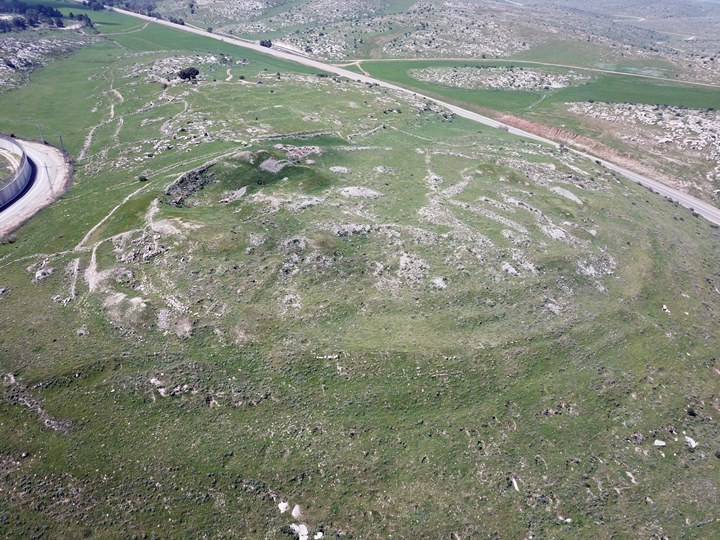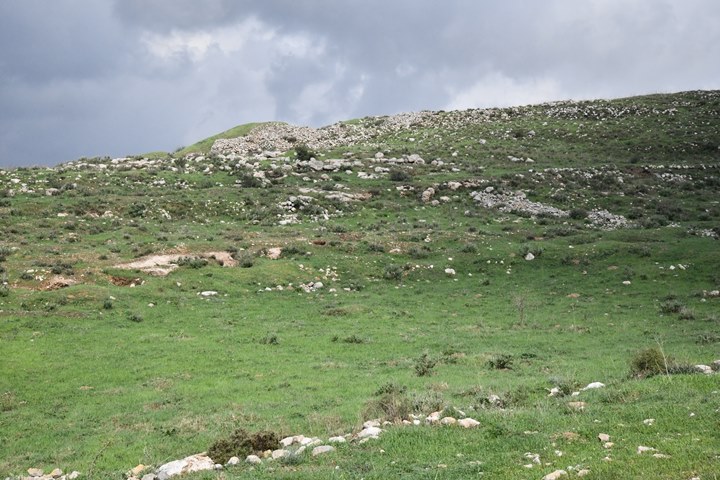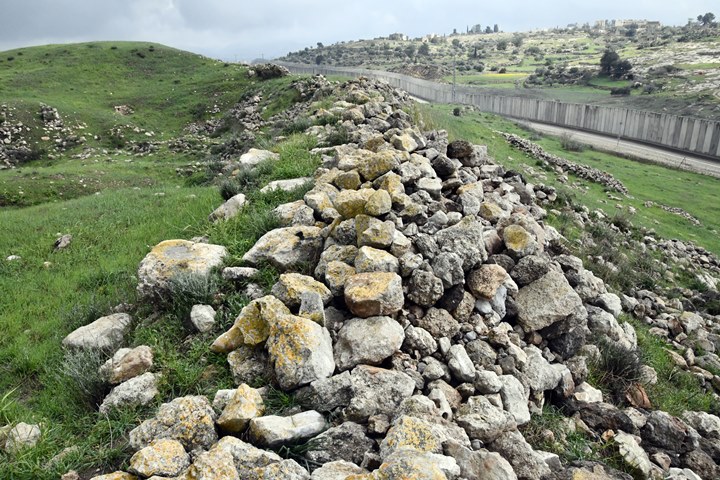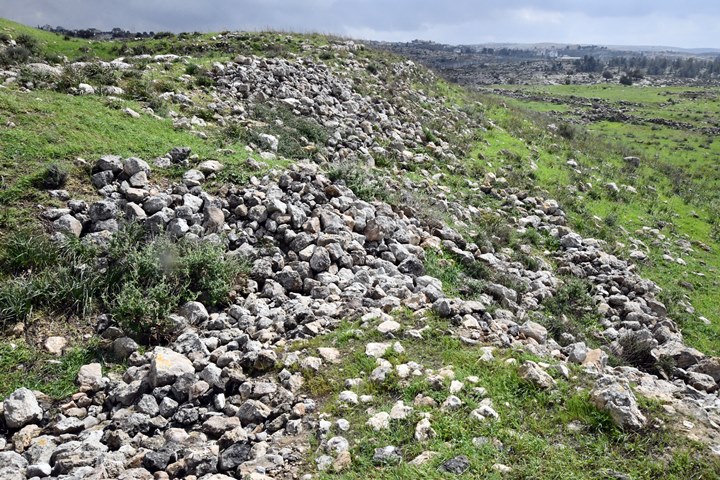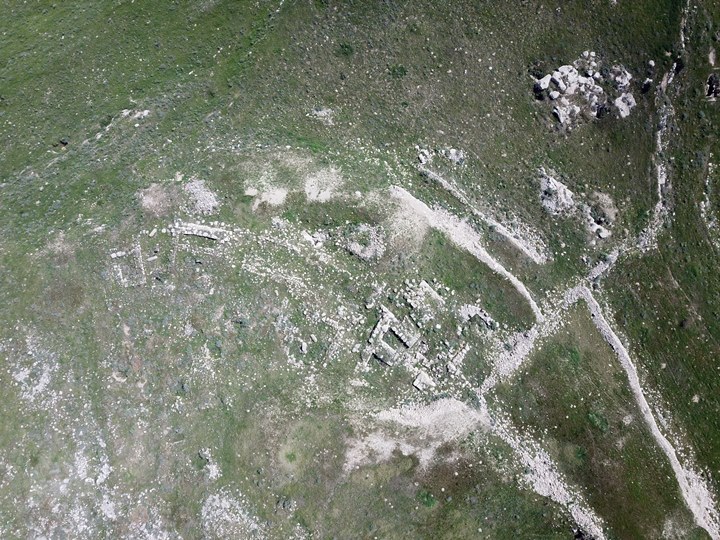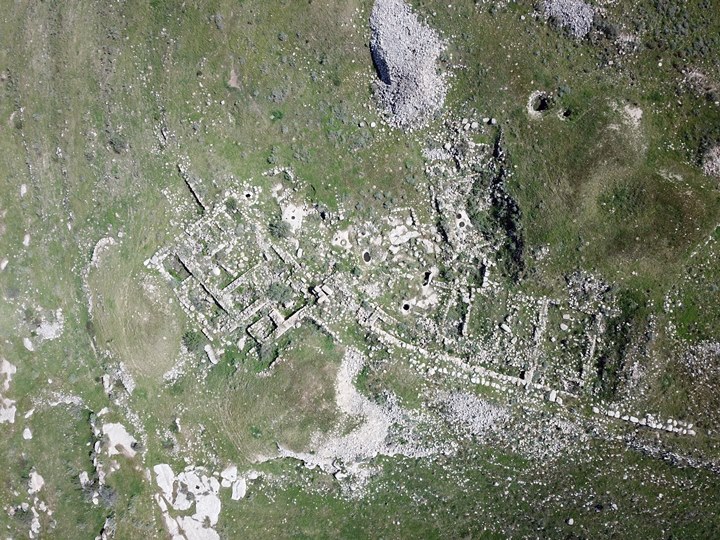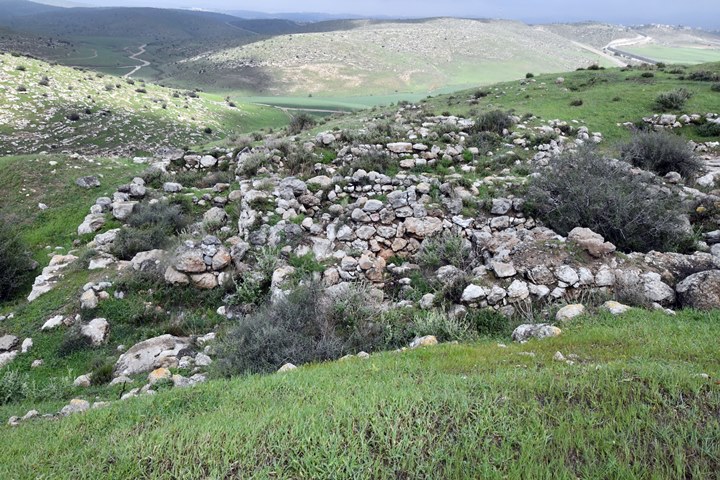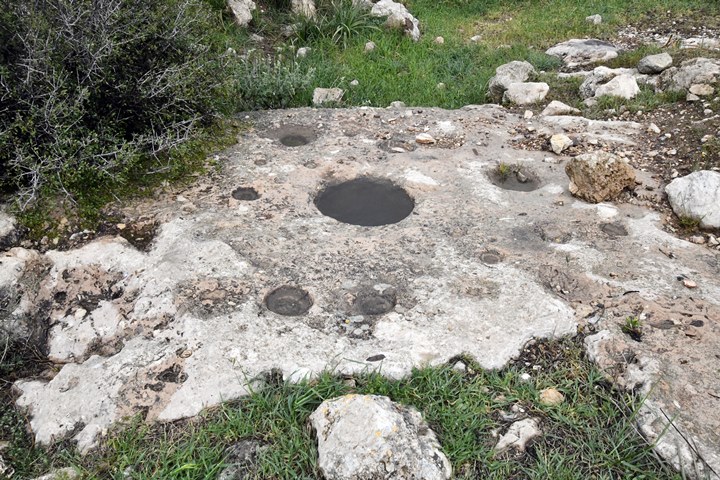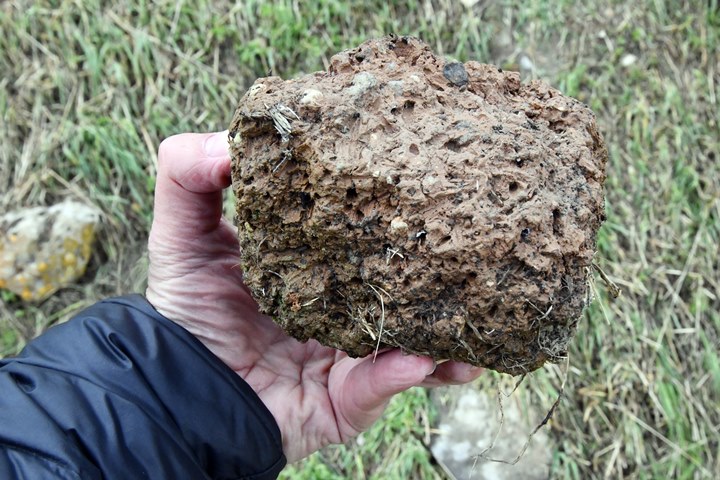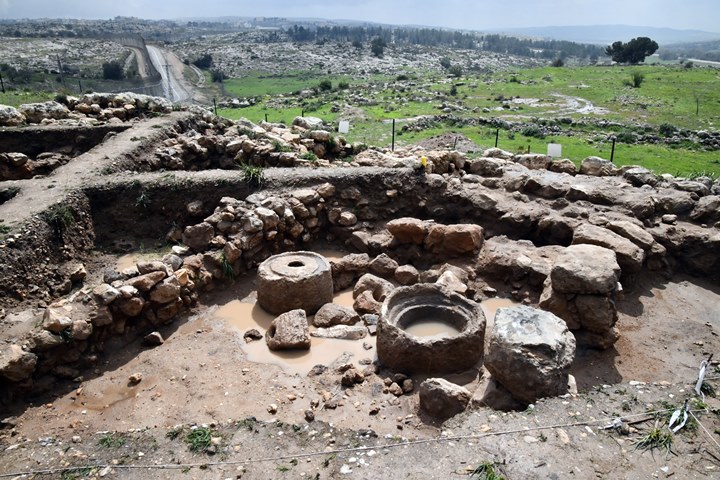Ruins of a large Canaanite and Israelite city in the southern low hills of Judea.
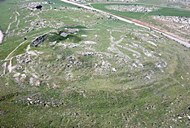
Home > Sites > Judea > Plains > Tell Beit Mirsim
Contents:
Background
Location
History
Identification
Photos
* Aerial views
* North views
* South Views
* Excavation photos
Etymology
Links
Overview:
On Tell Beit Mirsim, in the southern low hills of Judea, are ruins of a large Canaanite and Israelite city. The city was excavated in the 1920s by W.F. Albright who identified it as Kiryat Sepher or Debir (Joshua 15:15). This identification is not currently accepted by most scholars, who consider Khirbet Rabud (1KM west of Otniel) as the more likely location. One of the leading identifications is the Levitical city of Ashan, belonging to the tribes of Judah and Simeon. 1 Chronicles 6:59: “…And Ashan with her suburbs”.
Location and Aerial map:
Tel Beit Mirsim is located 4KM north east of Kibbutz Shomria. The mound is on the east side of the border road #358, which is parallel to the separation fence. It is on the Israeli west side, while the ruins of the Byzantine village are on the east side of the fence.
The mound covers an area of 30 dunams (3 hectares). The summit is at altitude of 473m above sea level, about 60m above the valley of Nahal Duma on the north side.

History of the place:
Cities and roads during the Canaanite and Israelite periods are indicated on the Biblical Map below, with the location of Tell Beit Mirsim marked with a red square on the south east side of the green colored plains of Judea. It is located 21 km (13 miles) south west of Hebron and 13 km (8 miles) south east of Lachish.
Although not shown in this map, there was a parallel south-north longitudinal route, built along the green colored area at the foothills of the Judean mountain area on this map. According to David Dorsey’s “The roads and highways of Ancient Israel”, a major NNE ancient road passed on the east side of Tell Beit Mirsim, connecting Beersheba to the valley of Aijalon. He marked it as “Sh1” (see pages 152-153), and it follows about the same route as modern highway #358. Many Bronze/Iron age places were constructed along this route, such as the adjacent Tell ‘Eton (marked here as Eglon) and the farther north – Adullam.
Map of the area around Tell Beit Mirsim (marked in red) – 20C BC through 6th C BC (based on Bible Mapper 3.0)
-
Canaanite Period (3150-1200 BC)
The first organized settlement started at about 2000 BC (Middle Bronze period), but was a small city. After a comparatively brief time the city was destroyed by fire. The Canaanite city was soon rebuilt, but this time (~17th Century BC) the second city was fortified by the Hyksos with very high walls (7m high), dry moat (3m deep) and a glacis. These formidable fortifications indicate this was a royal Canaanite city with great importance.
The city was partially destroyed in the mid 16th century. Its defense walls were rebuilt. From that period, during the years ~1500 to 1200, the city grew bigger and seem to have flourished. It was dominated by Egypt, as attested by Egyptian findings.
-
Israelite period (1200BC-1000BC)
The excavations revealed another destruction layer which they dated to the transition from the Bronze age to the Iron Age (13th to the 12th Century). This is the estimated time of the conquest of Joshua. After about 150 years the city was rebuilt with inferior fortifications – a 2m wide wall and smaller glacis. This indicates that the city status was degraded to a minor Israelite provisional city.
Albright identified the site as the Biblical Kiryat Sepher or Debir (Joshua 15:15): “And he went up thence to the inhabitants of Debir: and the name of Debir before was Kirjathsepher”.
-
The Israelite Kingdom – Iron Age II – (1000 – 586 BC)
During the Israelite Kingdom period, between the 10th and 9th Century, the city was once again partially destroyed, although it sustained less damage than in the previous conquest. The eastern gate was breached, but then it was repaired with a higher new wall around it. The western gate was destroyed and set on fire. The excavators relate this destruction to the intrusions of Shishak, king of Egypt (2 Chronicle 12:4):
“And it came to pass, that in the fifth year of king Rehoboam Shishak king of Egypt came up against Jerusalem, because they had transgressed against the LORD, With twelve hundred chariots, and threescore thousand horsemen: and the people were without number that came with him out of Egypt; the Lubims, the Sukkiims, and the Ethiopians. And he took the fenced cities which pertained to Judah, and came to Jerusalem”.
-
Assyrians (732-610 BC):
Beit Mirsim was destroyed again at the end of the 8th Century, probably during the Assyrian conquest.
The Assyrian empire, a rising force in the region, conquered the North Kingdom of Israel in 732BC, destroying most of the cities and villages in the land.
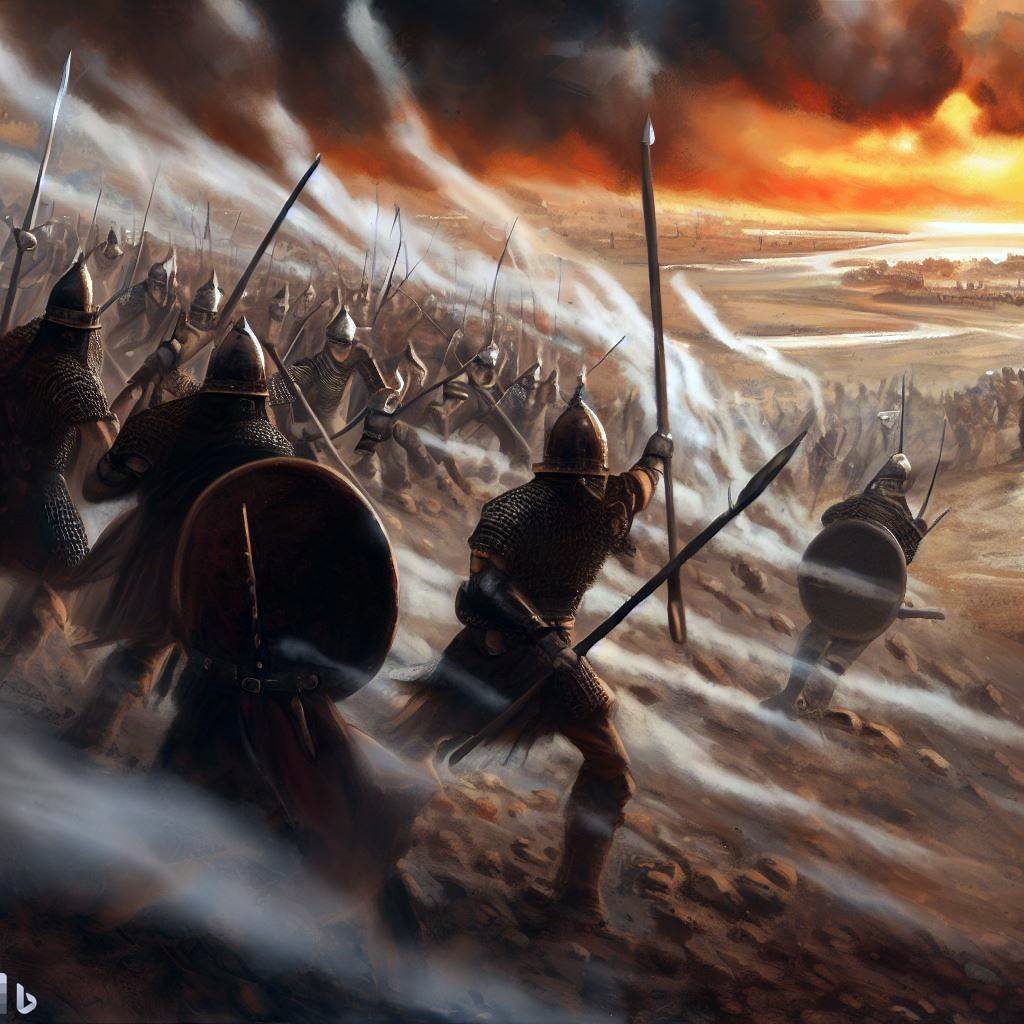
Assyrian forces attacking – AI generated by Bing
The South Kingdom of Judah managed to survive this onslaught by teaming up with the Assyrians, but not for long. After the death of the Assyrian King Sargon II (722 – 705BC), King Hezekiah mutinied against the Assyrians, joining other cities in the area who attempted to free themselves from the Assyrian conquest. Anticipating the coming Assyrian intrusion, he fortified Jerusalem and the major cities.
The Assyrian army came in 701 BC, led by Sennacherib, son of Sargon II (2 Chronicles 32 1): “After these things, and the establishment thereof, Sennacherib king of Assyria came, and entered into Judah, and encamped against the fenced cities, and thought to win them for himself”.
According to an Assyrian clay tablet, Sennacherib (Sin-Akhi-irba – “Sin multiply the brothers”) conquered 46 cities in Judea and carried off 200,150 of their inhabitants as prisoners.
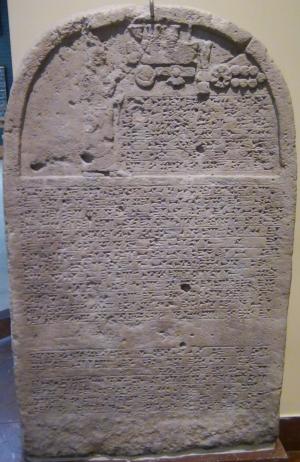
Sennacherib’s stele with relief and inscription; Ninveh;
limestone [Istanbul Archaeological Museum]
All in all, there were 5 destructions in the city. The Israelite city was never built again after 701 BC. Note that initial conclusions by Albright was a destruction in the 6th century, but this was found to be false.
-
Ottoman Period (19th century)
Conder and Kitchener surveyed this area during the Survey of Western Palestine (SWP) in 1873. A section of map 20 appears below, with Beit Mirsim in the center, showing a mound (Tell Beit Mirsim) at 163 feet, and ruins (Kh. Beit Mirsim) located to its south east side. An ancient road (marked by double dashed line) passes on the north and west side, connecting Hebron (on the east side, 16KM away) to the south.
Part of map Sheets 20 & 21 of Survey of Western Palestine, by Conder and Kitchener, 1872-1877.
(Published 1880, reprinted by LifeintheHolyLand.com)
The SWP report describes the two sites named Beit Mirsim on this map (SWP, Sheet XX, Vol 3, p 291 and 279):
“Tell Beit Mirsim – See Khurbet Beit Mirsim. The Tell formed the fortress”.
“Khurbet Beit Mirsim – A large ruin, looks like a ruined fortress to protect the road. A small ruined chapel with columns exists to the north”.
They added a report by Guerin:
‘This place is the ruin of a little city, not a village, which stood on the plateau of a high rocky hill. Hundreds of circular heaps of stone, cut or roughly squared, remains of overthrown houses, lie round caves or cellars cut in the rock. Some of these subterranean retreats are natural grottoes ; the others are cut by the hand of man. … To the west is a Tell, the Tell Mirsim. It is of very regular form, and the plateau on its summit has a circumference of 600 paces. It is now cultivated, but it appears to have been formerly surrounded by an enclosing wall rudely constructed. Materials from this wall or from other buildings now destroyed lie about here and there.’
– Guerin, Judea, ii. 349.
- Modern excavations
W.F. Albright conducted excavations at Tell Beit Mirsim during the 1920s and 1930s. These excavations exposed settlement layers from the Early, Middle and Late Bronze (Canaanite) periods, as well as the Iron age (Israelite) periods. Ten strata have been identified ranging from Early Bronze III through the Iron Age. Two Iron Age strata have been dated, with a total of 6 phases.
An illustration of the excavated areas on the mound is below. Two gates were exposed on the north east and the south west.
This excavation became a model for other archaeologist excavations in the Levant, as it produced the first definitive ceramic chronology of the Bronze and Iron Ages.

Map of Albright’s excavations on Tell Beit Mirsim
In 2004 a salvage excavation was conducted on the southern fringes of Tell Bit Mersim, in order to examine antiquities along the planned route of the separation fence. The fence was constructed as a barrier against the terrorist attacks from the West Bank. It follows, with some modifications, the eastern border of Israel with the West Bank, and is based on the 1949 Armistice “green line”.
Renewed excavations were conducted in 2021, headed by Igor Kreimerman of the Hebrew University. The team worked in area “A” on the south east side next to the old excavation area.
Identification:
The identification of Biblical sites is a challenge and many scholars attempted in mapping archaeology to history. There are hundreds of sites in the Levant, while only some of them can be identified with high confidence based on one or more evidences – their name, the description in the scripts, tradition, or hard evidence found in the excavations.
This is the case of Tell Beit Mirsim, where in spite of extensive excavations, the identification of the site is still based on various assumptions but with a low confidence. W.F. Albright was certain this city was Kiryat Sepher/Debir (as per Joshua 15:15), but this identification does not enjoy universal acceptance. Scholars have since came up with other suggested identifications.
According to an essay in “Ancient Israel and Its Neighbors: Interaction and Counteraction” (p. 329) by By Nadav Na’aman of the Tel Aviv University, as well as other articles, the following suggestions have been made on this site and other nearby places:
| Scholar | Tell Beit Mirsim | Tel ‘Eton | Kh. El Qom | Tell Bornat |
| W.F. Albright (1926) | Kiryat Sepher (Josh 15:15) | |||
| Elliger (1934) | Eglon (Joshua 12:12) | Libnah (Joshua 15:42) | ||
| Noth (1953), Rainey(1980) | Eglon (Joshua 12:12) | Makkedah (Josh 15:41) | Libnah (Joshua 15:42) | |
| Kellerman(1978),Dorsy (1980) | Makkedah (Josh 15:41) | |||
| Aharoni (1979) | Ashan (1 Chron. 6:44) | Etam (1 Chron 4:32) | Libnah (Joshua 15:42) | |
| Kallai (1962), Galil(1987) | Moreshetgath(Mic1:14) | |||
-
Is this the city of Ashan?
Based on this list, and assuming that the city of Eglon is best matched to Tel ‘Eton, then Tell Beit Mirsim could be identified with Ashan. The name means in Hebrew “smoke”. This city was listed in the region of Judea (Joshua 15:20, 42):
“This is the inheritance of the tribe of the children of Judah according to their families….Libnah, and Ether, and Ashan,…”.
The city is also listed in Chronicles as the inheritance of Judah’s son Shimei (1 Chronicles 4:32):
“And their villages were, Etam, and Ain, Rimmon, and Tochen, and Ashan, five cities”.
Ashan was also shared with the southern tribe of Simeon, or passed to them at later stage (Joshua 19: 1,7,9):
“And the second lot came forth to Simeon, even for the tribe of the children of Simeon according to their families: and their inheritance was within the inheritance of the children of Judah… Ain, Remmon, and Ether, and Ashan; four cities and their villages…Out of the portion of the children of Judah was the inheritance of the children of Simeon: for the part of the children of Judah was too much for them: therefore the children of Simeon had their inheritance within the inheritance of them”.
The city also appears in another form as ChorAsahn or BorAshan (smoking pit) in 1 Samuel 30:30, as a place where David sent the spoils of the Amalekites:
“And to them which were in Hormah, and to them which were in Chorashan, and to them which were in Athach”.
Ashan was one of the Levite cities. The Levite tribe members settled among the other tribe regions and had religious and political duties. In this text Ashan was listed as one of these cities (1 Chronicles 6:57-59):
“And to the sons of Aaron they gave the cities of Judah, namely, Hebron, the city of refuge, and Libnah with her suburbs, and Jattir, and Eshtemoa, with their suburbs, And Hilen with her suburbs, Debir with her suburbs, And Ashan with her suburbs, and Bethshemesh with her suburbs”.
Aharoni bases his identification on the similarity of the fortifications and layout between Tell Beit Mirsim and Beth Shemesh, another Levitical city, as one of his assumptions to identify it as Ashan.
We hope that future field works here and on other nearby sites, combined with more research studies, could bring forward more hard evidences to the identification of Tell Beit Mirsim.
Photos:
(a) Aerial views
A drone captured this view from the north side. The oval shaped mound rises over the area around it.
On the west side is a modern highway #358, while on the east side is the separation fence.
![]() Fly above and around the site with this YouTube video.
Fly above and around the site with this YouTube video.
Video captured on Mar 2023
(b) North views
This view is from the south side. Ruins of Tell Beit Mirsim are located on the mound, towering above the valley of Nahal Duma.
The road (#358) is parallel to the separation fence, which passes on the west (left) side of the mound.
Click on the photos to view in higher resolution…
Looking northward, the roads along the valley of Nahal Duma continues towards the Biblical cities of Tel ‘Eton (perhaps the city of Eglon) and Lachish. On the right hill are ancient remains called Khirbet Abu Mulassamah, meaning according to the SWP survey Arabic translation as ‘keeping on the road.’
Looking from this point towards the east are twin Arab villages, east of the separation fence, named Deir el-‘Asal al Fauqa (upper) and Deir el-‘Asal al Tachta (lower). The Arab word “‘Asl” means honey. The word “Deir” means a monastery, as the villages were built over a multi-period ancient site (el ‘Asal) which included a Byzantine Church.
(c) South views
A view from the south west side is shown below. The city wall is seen stretching along the top of the hill.
(d) Albright Excavation photos
W.F. Albright conducted excavations at Tell Beit Mirsim during the 1920s and 1930s. This section shows a sample of the excavation photos, as captured in 1926 by American Colony photographers. The photos are located in the Library of Congress online collection.
This photo collection is also called “Kirjath Sepher” or “Debir” photos, as Albright identified the site as the Biblical Kiryat Sepher or Debir (Joshua 15:15): “And he went up thence to the inhabitants of Debir: and the name of Debir before was Kirjathsepher”.
-
Excavation views
This photo shows the squares of the excavations:

A general view of the area after the excavations is in the next photo. Albright estimated that there were 150-200 houses with 2,000-3,000 people.
An interesting note in Albright’s summary of the extensive excavations of 1926 that all in all the cost of the expedition with 90 laborers was merely 3,000$ (that’s 40,000$ in 2015 value).

-
City Walls
Around the Iron Age city (Stratum B) was a casemate wall, a common plan during the Israelite period. Examples of such walls were found in other Iron Age cities such as Gezer, Beer Sheba, Yokneam, Aro’er and more. The casemate form (Hebrew: “Sogarim”) is based on two parallel walls (one external and one internal), which are connected at small intervals with inner walls, thus creating chambers. The chambers were used for storage and dwelling, and during war it could be reinforced by filling them with earth.
A view of the south eastern casemate wall is seen next, captured on March 2023 (100 years later than Albright’s excavations).
A tale of two walls: Notice the modern separation fence that was built on the east side of the site. The wall was built to prevent terrorist attacks and infiltrations coming from the territories.
The walls of the city were weaker on the north side, as that side is better protected due to the steep descent to the valley. However, the walls on the other sides were thick (4.5m) and high (7m on the external side). A dry moat was cut in the south west side, adding 3m additional height to the wall.
A view of the south west walls are seen in this view from the west side.
An old photo of the 1930s excavations shows a better view of a section of the southern Canaanite wall.

-
Eastern gate
There were two main gates in the city – an eastern gate (the main city gate) and western gate (also called west tower). The eastern gate was wider, and allowed entry of chariots. It connected to the main road on the east side of the city. The west gate was narrow, allowing only pedestrian access.
View of the excavated eastern gate is below, during the 1920s excavations. They revealed several phases in its construction – Late bronze age (2 phases) and an Iron Age I.
Most of the findings of the upper layer near the gate were dated to the Early Iron Age II period. In a lower layer the excavators dated the ceramics and other findings to the Middle and Late Bronze, and the Iron Age I period.

An aerial view of the eastern gate and the city walls is seen below. A section of the gate house extends beyond the walls.
- Western Gate
On the west side was the second city gate, although a smaller one that was used for pedestrian access. The gate house extends out of the city wall. This is an aerial view of the area around the gate:
A ground view of the western gate is seen in this photo, as viewed from the south side:
- Inner side:
Along the inner side of the city wall were typical Israelite “four-room houses”. This common type is found in other Iron Age cities such as Beer Sheba. It is a compact house with thick external walls and a single entrance, designed for protection. It supported a roof, or even a second level where additional residential rooms were located. This was a dwelling place for the family, kitchen, storerooms and also a place for the cattle (ox and mules). The standard type was a rectangular design covering a total area of 150-200 square meters. The design was based on a long house with four main spaces – a broad room in the back and three long spaces extending forward from it. The rooms were divided by stone pillars and walls. The central room was a courtyard, which was normally open to let in light since there were no windows in the house. Entrance to the complex was from a peripheral street.
Adjacent to the west gate are bases of structures and a number of installations:
Among the ruins are sun dried mud bricks, which were used to raise the height of the walls.
Sun-dried mud bricks have a long history of use in the Levant. These bricks, also known as adobe bricks, were commonly used in the construction of homes, buildings, and other structures due to their low cost and easy availability.
The process of making sun-dried mud bricks involves mixing mud with straw or other organic material, shaping the mixture into brick-sized molds, and then drying the bricks in the sun. This process has been used for thousands of years, with evidence of sun-dried mud bricks dating back to the Bronze Age in the Levant.
Despite their widespread use, sun-dried mud bricks have some drawbacks, such as their vulnerability to water damage and their susceptibility to erosion over time. However, they remain an important part of the architectural heritage of the Levant and continue to be used in some regions for their low cost and eco-friendliness.
-
High Place
The next photo is a view of the high place in Tell Beit Mirsim.

A view of the east shrine on the high place:

-
Dye Vats? Oil presses?
A large number of “dye vat” installations were discovered on Tell Beit Mirsim. The complex, dated to the Iron Age (~8th Century BC), includes an elaborate set of tanks, vats, channels, and loom weights. The excavations found 6-7 such installations, and the estimate was a staggering number of ~30 textile complexes. Albright therefore concluded that this was a town guild of dyers and weavers.
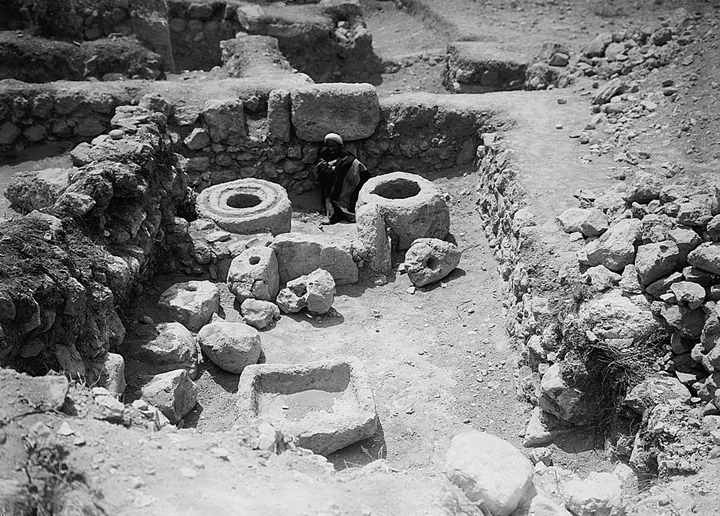
The following photo shows the excavators measuring one of the dye vat stones. Each vat (dyeing bucket) consisted of a single chunk of this round carved limestone. The hole in the center permitted a single thread to be dyed. The groove around the rim of the stone led the excess colored substance to pour back into the vat.
Textile dyeing was a lucrative business in ancient times, as colorful clothes were precious. A verse in the song of Deborah compares colorful clothes to precious booty (Judges 5:30): “… to Sisera a prey of divers colors, a prey of divers colors of needlework, of divers colors of needlework on both sides, meet for the necks of them that take the spoil?”. Joseph’s multi color garment caused his brothers to be envy and conspire to kill him (Genesis 36 3): “Now Israel loved Joseph more than all his children, … and he made him a coat of many colors”.

The Bible specifies a blue dye (Tekhelet) for use in the Priestly garments as well in the layman’s tzizit (a fringe in the upper garment). For example (Exodus 28:6): “And they shall make the ephod of gold, of blue, and of purple, of scarlet, and fine twined linen, with cunning work”. Purple color dyeing, based on extracting the color from marine snails (Murex trunculus), was one of the important sources of dye colors in antiquity. The Canaanites, Hebrews of the Zebulun tribe, and especially the Phoenicians produced the deep-purple indigo dye which was used for the textile industry. Purple became a symbol of status, sovereignty and power.
A similar “dye vat” installation is seen in this new photo of Area A, excavated in 2021. The archaeologists have reconsidered the theory of the dye vats, and propose that these installations were actually used for olive oil production, with one of this cylinders was a olive crasher (first step of the process) and the other was used for pressing the crushed olives and storing the extracted oil (second step in the olive oil process) .
Another installation is in the next photo:

-
Spring
Two wells are located to the north and south of the site. The co-director of the excavations M. G. Kyle wrote in his memoir that the southern well, seen in the next photo, was used by the excavation team for their water supply. The southern well was named the “Nether” spring, based on the Biblical text found in the description of the territory of the tribe of Judah (Joshua 15:1,13-19):
“This then was the lot of the tribe of the children of Judah by their families… And unto Caleb the son of Jephunneh he gave a part among the children of Judah, according to the commandment of the LORD to Joshua, even the city of Arba the father of Anak, which city is Hebron. And Caleb drove thence the three sons of Anak, Sheshai, and Ahiman, and Talmai, the children of Anak. And he went up thence to the inhabitants of Debir: and the name of Debir before was Kirjathsepher. And Caleb said, He that smiteth Kirjathsepher, and taketh it, to him will I give Achsah my daughter to wife. And Othniel the son of Kenaz, the brother of Caleb, took it: and he gave him Achsah his daughter to wife. And it came to pass, as she came unto him, that she moved him to ask of her father a field: and she lighted off her ass; and Caleb said unto her, What wouldest thou? Who answered, Give me a blessing; for thou hast given me a south land; give me also springs of water. And he gave her the upper springs, and the nether springs“.

Etymology (behind the name):
* Names of the site:
- Tell Beit Mirsim – Arabic – The mound of the house of Mirsim. Mirsim was translated by the SWP dictionary as ambling – a slow stroll (of a horse).
- Beit Mirsham – The Hebrew name, based on the Arabic name.
- Kirjath Sepher – Hebrew: book city. A city in Judea (Joshua 15:15): “And he went up thence to the inhabitants of Debir: and the name of Debir before was Kirjathsepher”.
* Other names:
- Shomria – a Kibbutz communal settlement, established in 1985. In 2006 it accepted settlers that were evacuated from the settlement of Bnei Atzmon in the Gaza strip.
Links:
* External:
- Tell Beit Mirsim – Hadashot Arkheologiyot 2007
- The excavations at Tell Beit Mirsim W.F. Albright, Basor 1926 (pdf, 12 pages)
- New Light on the Early Iron Age at Tell Beit Mirsim R. Greenberg, Basor 1987 pp55-80 (article)
- MG Kyle at Tell Beit Mirsim 1926-1932 Presentation on Youtube, historic film of the excavations
- Library of Congress online collection excavation photos
- Excavating Kirjath-Sepher’s Ten Cities – Melvin Grove Kyle (Book, published 2007 based on 1932 memoirs)
- Juhadite Refortification of the Lachish frontier – J. A. Blakely, 1981, pdf 429 pages
- Renewed excavations – 1st season 2021, Youtube presentation by Dr. Igor Kreimerman
- Back to Tell Beit Mirsim – preliminary results of renewed excavations ( 2022, Igor Kreimerman et. al.)
* Internal:
- Drone Aerial views – collection of Biblical sites from the air
- Oil pressers in the Holy Land
BibleWalks.com – Have Bible, will Travel!
Tel ‘Eton<<<—previous site—<<< All Sites >>>—next Judea site—>>>Herodion
This page was last updated on Aug 16, 2023 (change AI illus.)
Sponsored links:
